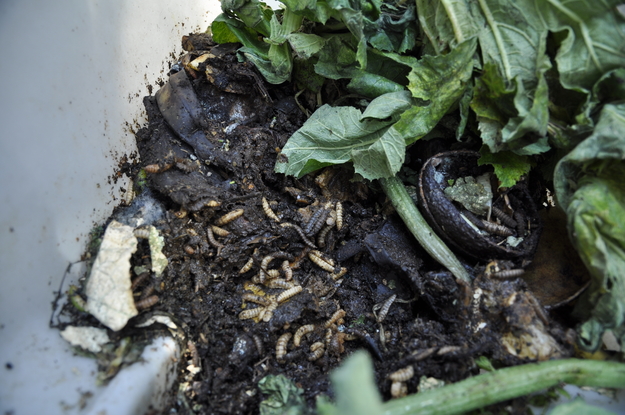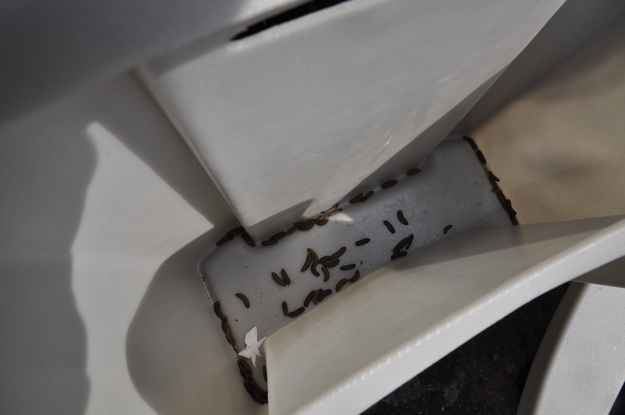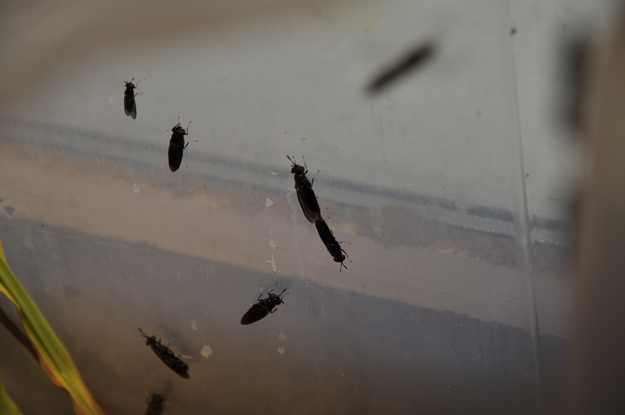This page will follow our investigation and trial of producing black soldier fly (bsf) larvae as a composting system and food source for fish (and humans?).
30th September 2014 - Protix Biosystems BV, an innovator in insect nutrition and technology, has generously provided bsf prepupae for us to use as a primary food source for our fish. This has allowed us to concentrate on the entire bsf life cycle and allow our pupae to develop into flies, while assessing the impact of using bsf as fish food, compared to regular fish meal.
15th September 2014 - Having now completed a complete life cycle of the black soldier fly, we can reflect on the process and some of the successes and challenges. By completing the life-cycle, this means growing out black soldier fly eggs (produced by the bsf larvae we originally purchased) to the fly stage and producing eggs to restart the process. The larvae to pupae stage was relatively straightforward, as the compost bin is pre-designed for this purpose. The pupae to fly stage was also relatively easy, once an appropriate light and humidity level was achieved. The most persistent challenge has been getting the flies to lay eggs in the desired areas, making transferring back to the compost bin far easier. Currently most flies are laying eggs somewhere in the enclosure and only after hatching and the larvae becoming visible to the eye do we discover them. This makes transfer difficult and makes the process more labor intensive.
16th June 2014 - Many flies have now emerged and rampant breeding is observed. Bsf are observed congregating on the cardboard egg strips, however we are unsure at this stage if they are laying eggs. The enclosure is quickly filling with flies and a new, more powerful lamp is being used to raise the temperature for breeding (30-35 degrees). More to come..
14 June 2014 - Flies! We are greeted with the first flies to emerge. Others are following quickly throughout the day. Initially no breeding is observed, however with a 5-8 day life span, we expect this to follow shortly. Cardboard (picture) with exposed grooves is placed in the enclosure for egg laying, along with ‘juice’ from the bottom of the compost enclosure to stimulate mating.
7 June 2014 - After a brief period of fast composting, the rate has slowed as most bsf larvae have turned into pupae and climbed out of the composting enclosure into the collection bucket (self harvesting!). From here the pupae are transferred to a new enclosure to be stimulated into morphing into flies and following this, breeding.
Morphing / Breeding Enclosure: This is a simple design aimed at keeping the temperature in a range of 25-30 degrees and a high humidity level (70-90%). A 3cm base of potting soil and sawdust is added to a 60-70 liter plastic container. Water is sprayed into the enclosure to keep the humidity up, with a plastic lid (partially covering top) used to regulate temperature. A desk lamp is used for extra light, as well as placing the enclosure next to a window for natural light. A small pot plant and a covered cup of water (so flies don't drown) were added for assisting breeding. The pupae burrow down into the soil when placed inside. Now we wait..
26 May 2014 - Bsf larvae are settling in to the enclosure and are starting to break down the initial layer of food scraps. A second layer of scraps has been added; at this stage the composting rate is much slower than we would expect once the system is established. The enclosure seems to be retaining heat and we have had some pupae self harvest into the collection bucket (below). We will now start to add food scraps more regularly and work on the crucial stage of fly breeding so the population can continue.
17 May 2014 - New batch of bsf larvae arrived, this time in much better health. We have placed them in the enclosure along with around 10cm of food scraps from the kitchen, all under cardboard for shade and warmth. In order to keep the temperature up, they are currently in the outdoor greenhouse in a shaded area. We will now see how they take to the new environment and monitor how fast they are getting through the first batch of food scraps before we add anything else.
6 May 2014 - Black soldier fly (bsf) larvae arrived via post. Nearly all were dead due to delays in delivery. A small number were still alive, however they also died soon after being placed in the bsf enclosure. Another order has been placed and we hope this time the delivery issues will be fixed. In the meantime we continue to research on alternative methods of feeding fish.


